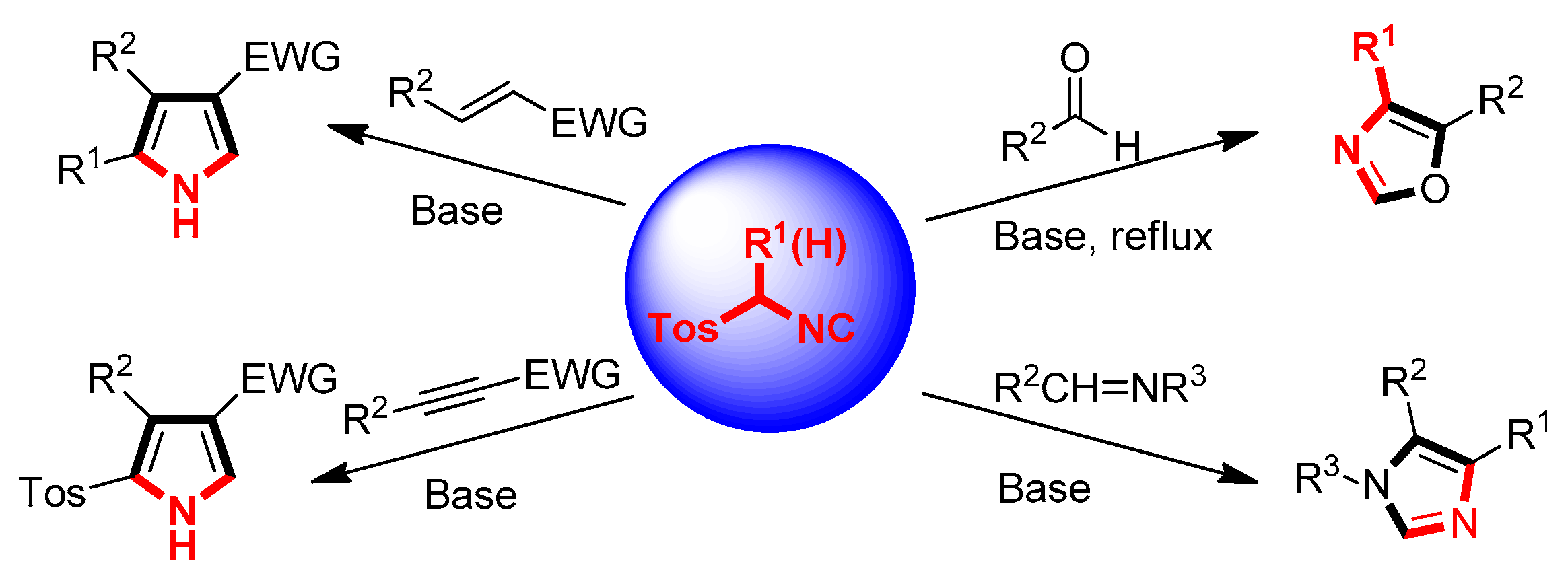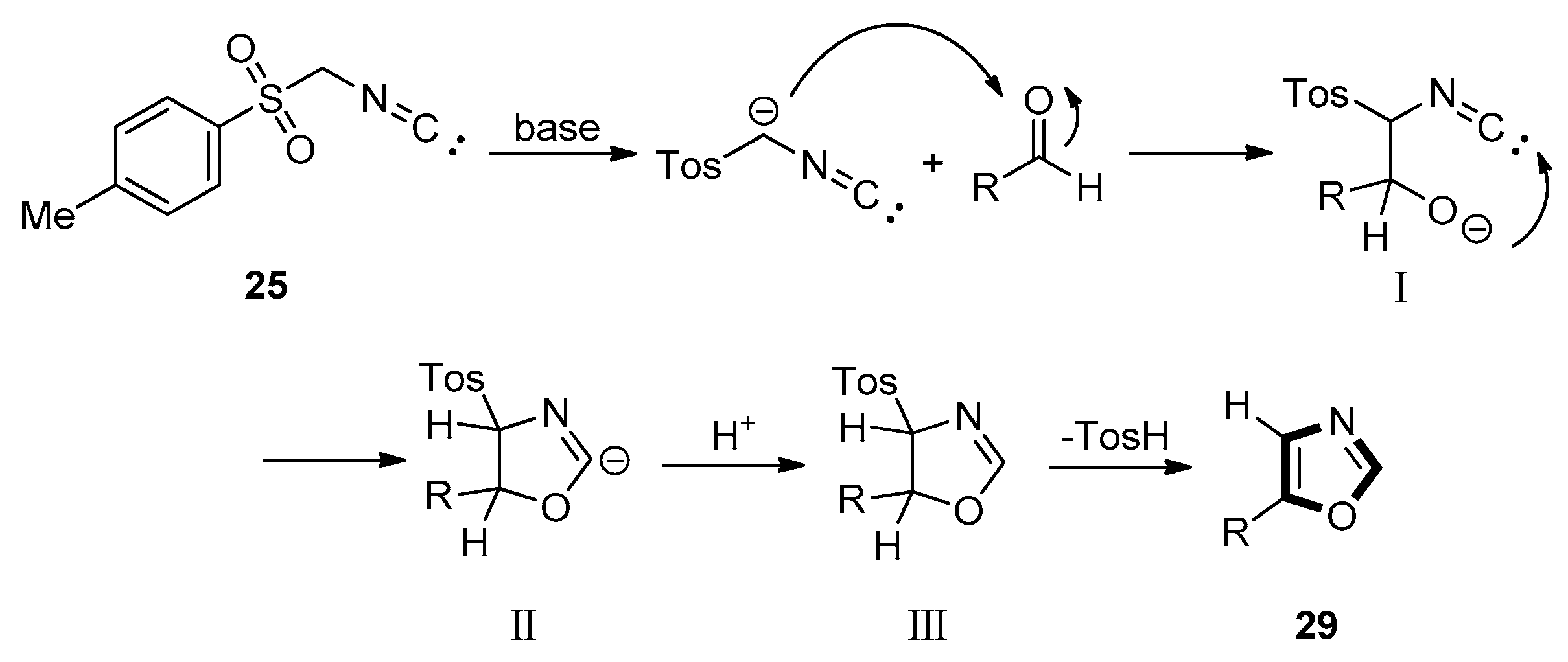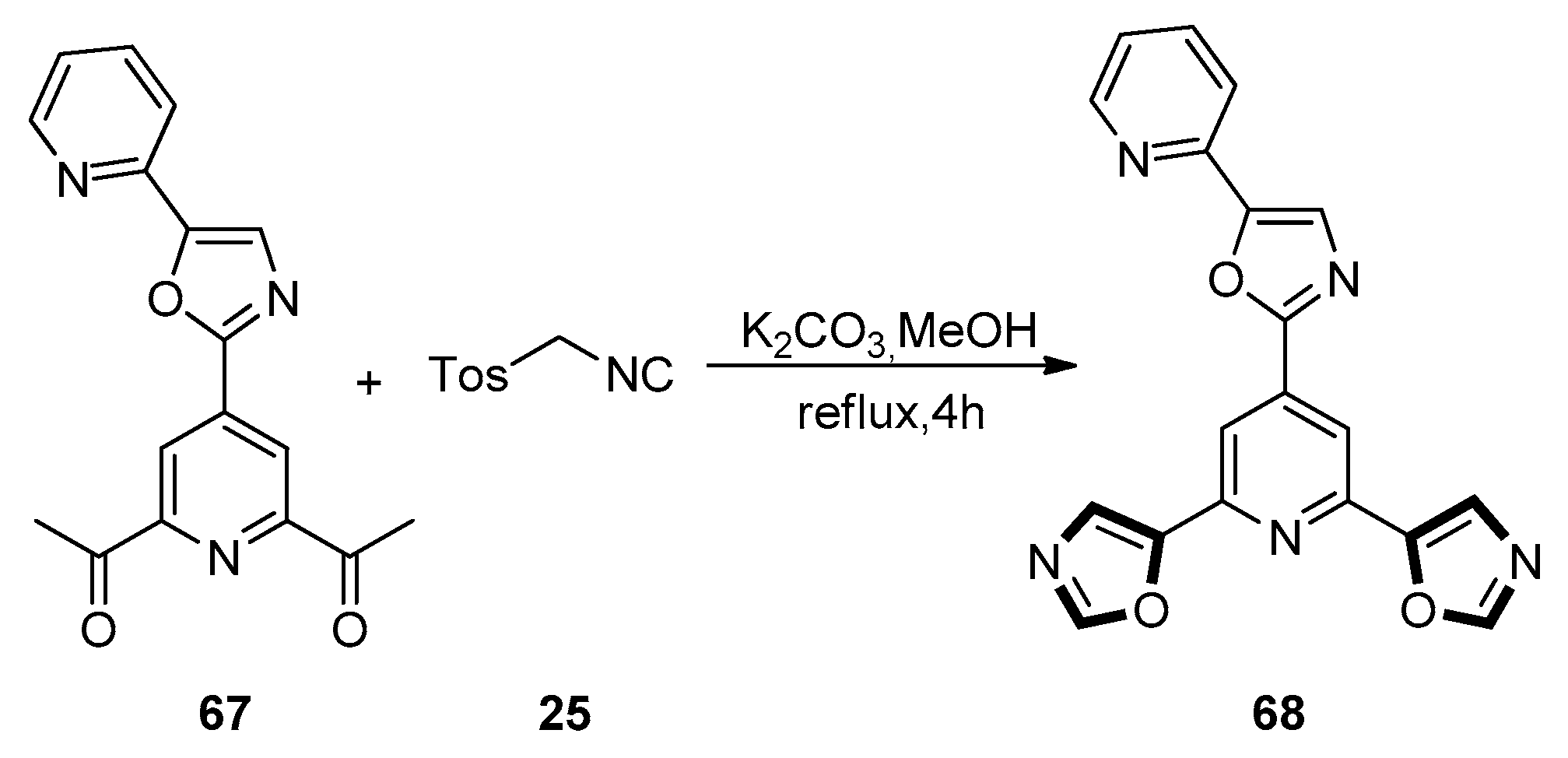Recent Advances in the Synthesis of Oxazole-Based Molecules via van Leusen Oxazole Synthesis
Abstract
:1. Introduction
2. General van Leusen Oxazole Synthesis
3. Developments of the van Leusen Oxazole Synthesis
4. Conclusions
Author Contributions
Funding
Conflicts of Interest
References
- Zhang, H.Z.; Zhao, Z.L.; Zhou, C.H. Recent advance in oxazole-based medicinal chemistry. Eur. J. Med. Chem. 2018, 144, 444–492. [Google Scholar] [CrossRef] [PubMed]
- Kaur, R.; Palta, K.; Kumar, M.; Bhargava, M.; Dahiya, L. Therapeutic potential of oxazole scaffold: A patent review (2006–2017). Expert Opin. Ther. Pat. 2018, 28, 783–812. [Google Scholar] [CrossRef] [PubMed]
- Kakkar, S.; Narasimhan, B. A comprehensive review on biological activities of oxazole derivatives. BMC Chem. 2019, 13. [Google Scholar] [CrossRef] [PubMed] [Green Version]
- Chiacchio, M.A.; Lanza, G.; Chiacchio, U.; Giofre, S.V.; Romeo, R.; Iannazzo, D.; Legnani, L. Oxazole-based compounds as anticancer agents. Curr. Med. Chem. 2019, 26, 7337–7371. [Google Scholar] [CrossRef]
- Aljaar, N.; Gujjarappa, R.; Al-Refai, M.; Shtaiwi, M.; Malakar, C.C. Overview on recent approaches towards synthesis of 2-keto-annulated oxazole derivatives. J. Heterocycl. Chem. 2019, 56, 2730–2743. [Google Scholar] [CrossRef]
- Škedelj, V.; Perdih, A.; Brvar, M.; Kroflič, A.; Dubbée, V.; Savage, V.; O’Neill, A.J.; Solmajer, T.; Bešter-Rogač, M.; Blanot, D.; et al. Discovery of the first inhibitors of bacterial enzyme d-aspartate ligase from Enterococcus faecium (Aslfm). Eur. J. Med. Chem. 2013, 67, 208–220. [Google Scholar] [CrossRef]
- Li, N.N.; Xu, Y.T.; Xia, Q.; Bai, C.G.; Wang, T.Y.; Wang, L.; He, D.D.; Xie, N.N.; Li, L.X.; Wang, J.; et al. Simplified captopril analogues as NDM-1 inhibitors. Bioorgan. Med. Chem. Lett. 2014, 24, 386–389. [Google Scholar] [CrossRef]
- Patil, P.C.; Tan, J.; Demuth, D.R.; Luzzio, F.A. 1,2,3-Triazole-based inhibitors of Porphyromonas gingivalis adherence to oral streptococci and biofilm formation. Bioorgan. Med. Chem. 2016, 24, 5410–5417. [Google Scholar] [CrossRef] [Green Version]
- Tomi, I.H.R.; Tomma, J.H.; Al-Daraji, A.H.R.; Al-Dujaili, A.H. Synthesis, characterization and comparative study the microbial activity of some heterocyclic compounds containing oxazole and benzothiazole moieties. J. Saudi Chem. Soc. 2015, 19, 392–398. [Google Scholar] [CrossRef] [Green Version]
- Pedras, M.S.; Abdoli, A. Metabolism of the phytoalexins camalexins, their bioisosteres and analogues in the plant pathogenic fungus Alternaria brassicicola. Bioorgan. Med. Chem. 2013, 21, 4541–4549. [Google Scholar] [CrossRef]
- Zhang, M.Z.; Jia, C.Y.; Gu, Y.C.; Mulholland, N.; Turner, S.; Beattie, D.; Zhang, W.H.; Yang, G.F.; Clough, J. Synthesis and antifungal activity of novel indole-replaced streptochlorin analogues. Eur. J. Med. Chem. 2017, 126, 669–674. [Google Scholar] [CrossRef] [PubMed]
- Nagashima, S.; Matsushima, Y.; Hamaguchi, H.; Nagata, H.; Kontani, T.; Moritomo, A.; Koshika, T.; Takeuchi, M. Novel quinuclidinyl heteroarylcarbamate derivatives as muscarinic receptor antagonists. Bioorgan. Med. Chem. 2014, 22, 3478–3487. [Google Scholar] [CrossRef] [PubMed]
- Perrone, M.G.; Vitale, P.; Panella, A.; Fortuna, C.G.; Scilimati, A. General role of the amino and methylsulfamoyl groups in selective cyclooxygenase(COX)-1 inhibition by 1,4-diaryl-1,2,3-triazoles and validation of a predictive pharmacometric PLS model. Eur. J. Med. Chem. 2015, 94, 252–264. [Google Scholar] [CrossRef] [PubMed]
- Otrubova, K.; Cravatt, B.F.; Boger, D.L. Design, Synthesis, and Characterization of α-Ketoheterocycles That additionally target the cytosolic port Cys269 of fatty acid amide hydrolase. J. Med. Chem. 2014, 57, 1079–1089. [Google Scholar] [CrossRef]
- Draffan, A.G.; Frey, B.; Fraser, B.H.; Pool, B.; Gannon, C.; Tyndall, E.M.; Cianci, J.; Harding, M.; Lilly, M.; Hufton, R.; et al. Derivatives of imidazotriazine and pyrrolotriazine C-nucleosides as potential new anti-HCV agents. Bioorgan. Med. Chem. Lett. 2014, 24, 4984–4988. [Google Scholar] [CrossRef]
- Zhong, Z.J.; Zhang, D.J.; Peng, Z.G.; Li, Y.H.; Shan, G.Z.; Zuo, L.M.; Wu, L.T.; Li, S.Y.; Gao, R.M.; Li, Z.R. Synthesis and antiviral activity of a novel class of (5-oxazolyl)phenyl amines. Eur. J. Med. Chem. 2013, 69, 32–43. [Google Scholar] [CrossRef]
- Kim, S.H.; Markovitz, B.; Trovato, R.; Murphy, B.R.; Austin, H.; Willardsen, A.J.; Baichwal, V.; Morham, S.; Bajji, A. Discovery of a new HIV-1 inhibitor scaffold and synthesis of potential prodrugs of indazoles. Bioorgan. Med. Chem. Lett. 2013, 23, 2888–2892. [Google Scholar] [CrossRef]
- Meissner, A.; Boshoff, H.I.; Vasan, M.; Duckworth, B.P.; Barry, C.E., III; Aldrich, C.C. Structure-activity relationships of 2-aminothiazoles effective against Mycobacterium tuberculosis. Bioorgan. Med. Chem. Lett. 2013, 21, 6385–6397. [Google Scholar] [CrossRef] [Green Version]
- Abhale, Y.K.; Sasane, A.V.; Chavan, A.P.; Shekh, S.H.; Deshmukh, K.K.; Bhansali, S.; Nawale, L.; Sarkar, D.; Mhaske, P.C. Synthesis and antimycobacterial screening of new thiazolyl-oxazole derivatives. Eur. J. Med. Chem. 2017, 132, 333–340. [Google Scholar] [CrossRef]
- Li, D.S.; Gao, N.N.; Zhu, N.Y.; Lin, Y.; Li, Y.; Chen, M.H.; You, X.F.; Lu, Y.; Wan, K.L.; Jiang, J.D.; et al. Discovery of the disubstituted oxazole analogues as a novel class anti-tuberculotic agents against MDR- and XDR-MTB. Bioorgan. Med. Chem. Lett. 2015, 25, 5178–5181. [Google Scholar] [CrossRef]
- Lu, X.W.; Wu, Y.K. On the structure of aspongopusin recently isolated from Aspongopus chinensis. Fitoterapia 2013, 84, 318–320. [Google Scholar] [CrossRef] [PubMed]
- Wu, C.; Liang, Z.W.; Xu, Y.Y.; He, W.M.; Xiang, J.N. Gold-catalyzed oxazoles synthesis and their relevant antiproliferative activities. Chin. Chem. Lett. 2013, 24, 1064–1066. [Google Scholar] [CrossRef]
- Maini, R.; Dedkova, L.M.; Paul, R.; Madathil, M.M.; Chowdhury, S.R.; Chen, S.; Hecht, S.M. Ribosome-mediated incorporation of dipeptides and dipeptide analogues into proteins in vitro. J. Am. Chem. Soc. 2015, 137, 11206–11209. [Google Scholar] [CrossRef] [PubMed] [Green Version]
- Taha, M.; Ismail, N.H.; Imran, S.; Anouar, E.H.; Selvaraj, M.; Jamil, W.; Ali, M.; Kashif, S.M.; Rahim, F.; Khan, K.M.; et al. Synthesis and molecular modelling studies of phenyl linked oxadiazole-phenylhydrazone hybrids as potent antileishmanial agents. Eur. J. Med. Chem. 2017, 126, 1021–1033. [Google Scholar] [CrossRef] [PubMed]
- Yamamuro, D.; Uchida, R.; Ohtawa, M.; Arima, S.; Futamura, Y.; Katane, M.; Homma, H.; Nagamitsu, T.; Osada, H.; Tomoda, H. Synthesis and biological activity of 5-(4-methoxyphenyl)-oxazole derivatives. Bioorgan. Med. Chem. Lett. 2015, 25, 313–316. [Google Scholar] [CrossRef]
- Da Rosa, R.; de Moraes, M.H.; Zimmermann, L.A.; Schenkel, E.P.; Steindel, M.; Bernardes, L.S.C. Design and synthesis of a new series of 3,5-disubstituted isoxazoles active against Trypanosoma cruzi and Leishmania amazonensis. Eur. J. Med. Chem. 2017, 128, 25–35. [Google Scholar] [CrossRef]
- Yoon, D.S.; Wu, S.C.; Seethala, R.; Golla, R.; Nayeem, A.; Everlof, J.G.; Gordon, D.A.; Hamann, L.G.; Robl, J.A. Discovery of pyridyl sulfonamide 11-beta-hydroxysteroid dehydrogenase type 1 (11β-HSD1) inhibitors for the treatment of metabolic disorders. Bioorgan. Med. Chem. Lett. 2014, 24, 5045–5049. [Google Scholar] [CrossRef]
- Kalwat, M.A.; Huang, Z.; Wichaidit, C.; McGlynn, K.; Earnest, S.; Savoia, C.; Dioum, E.M.; Schneider, J.W.; Hutchison, M.R.; Cobb, M.H. Isoxazole alters metabolites and gene expression, decreasing proliferation and promoting a neuroendocrine phenotype in β-Cells. ACS Chem. Biol. 2016, 11, 1128–1136. [Google Scholar] [CrossRef] [Green Version]
- Zahanich, I.; Kondratov, I.; Naumchyk, V.; Kheylik, Y.; Platonov, M.; Zozulya, S.; Krasavin, M. Phenoxymethyl 1,3-oxazoles and 1,2,4-oxadiazoles as potent and selective agonists of free fatty acid receptor 1 (GPR40). Bioorgan. Med. Chem. Lett. 2015, 25, 3105–3111. [Google Scholar] [CrossRef]
- Van Leusen, A.M.; Hoogenboom, B.E.; Siderius, H. A novel and efficient synthesis of oxazoles from tosylmethylisocyanide and carbonyl compounds. Tetrahedron Lett. 1972, 13, 2369–2372. [Google Scholar] [CrossRef]
- Cornforth, J.W.; Huang, H.T. Synthesis of a 4-cyano-oxazole. J. Chem. Soc. 1948, 1969–1971. [Google Scholar] [CrossRef]
- Fischer, E. Neue bildungsweise der oxazole. Eur. J. Inorg. Chem. 1896, 29, 205–214. [Google Scholar] [CrossRef] [Green Version]
- Doyle, M.P.; Buhro, W.E.; Davidson, J.G.; Elliott, R.C.; Hoekstra, J.W.; Oppenhuizen, M. Lewis acid promoted reactions of diazocarbonyl compounds. 3. Synthesis of oxazoles from nitriles through intermediate. beta-imidatoalkenediazonium salts. J. Org. Chem. 1980, 45, 3657–3664. [Google Scholar] [CrossRef]
- Dalla Vechia, L.; de Souza, R.O.M.A.; Miranda, L.S.D.E. The Dakin-West reaction: Past, present and future. Tetrahedron 2018, 74, 4359–4371. [Google Scholar] [CrossRef]
- Wasserman, H.H.; Vinick, F.J. Mechanism of the Robinson-Gabriel synthesis of oxazoles. J. Org. Chem. 1973, 38, 2407–2408. [Google Scholar] [CrossRef]
- Tandon, V.K.; Rai, S. p-Toluenesulfonylmethyl isocyanide: A versatile synthon in organic chemistry. Sulfur Rep. 2003, 24, 307–385. [Google Scholar]
- Akritopoulou-Zanze, I. Isocyanide-based multicomponent reactions in drug discovery. Curr. Opin. Chem. Biol. 2008, 12, 324–331. [Google Scholar] [CrossRef]
- Lujan-Montelongo, J.A.; Estevez, A.O.; Fleming, F.F. Alkyl sulfinates: Formal nucleophiles for synthesizing TosMIC analogs. Eur. J. Org. Chem. 2015, 2015, 1602–1605. [Google Scholar] [CrossRef]
- Mathiyazhagan, A.D.; Anilkumar, G. Recent advances and applications of p-toluenesulfonylmethyl isocyanide (TosMIC). Org. Biomol. Chem. 2019, 17, 6735–6747. [Google Scholar] [CrossRef]
- Van Leusen, D.; van Leusen, A.M. Synthetic uses of tosylmethyl isocyanide (TosMIC). Org. React. 2001, 57, 417–666. [Google Scholar]
- Ma, Z.N.; Ma, Z.C.; Zhang, D.W. Synthesis of multi-substituted pyrrole derivatives through [3+2] cycloaddition with tosylmethylisocyanides (TosMICs) and electron-deficient compounds. Molecules 2018, 23, 2666. [Google Scholar] [CrossRef] [PubMed] [Green Version]
- Zheng, X.N.; Ma, Z.N.; Zhang, D.W. Synthesis of imidazole-based medicinal molecules utilizing the van leusen imidazole synthesis. Pharmaceuticals 2020, 13, 37. [Google Scholar] [CrossRef] [PubMed] [Green Version]
- Kulkarni, B.A.; Ganesan, A. A solid-phase equivalent of van Leusen’s TosMIC, and its application in oxazole synthesis. Tetrahedron Lett. 1999, 40, 5633–5636. [Google Scholar] [CrossRef]
- Kulkarni, B.A.; Ganesan, A. Solution-phase parallel oxazole synthesis with TosMIC. Tetrahedron Lett. 1999, 40, 5637–5638. [Google Scholar] [CrossRef]
- Sisko, J.; Kassick, A.J.; Mellinger, R.; Filan, J.J.; Allen, A.; Olsen, M.A. An investigation of imidazole and oxazole syntheses using aryl-substituted TosMIC reagents. J. Org. Chem. 2000, 65, 1516–1524. [Google Scholar] [CrossRef] [PubMed]
- Chakrabarty, M.; Basak, R.; Harigaya, Y.; Takayanagi, H. Reaction of 3/2-formylindoles with TosMIC: Formation of indolyloxazoles and stable indolyl primary enamines. Tetrahedron 2005, 61, 1793–1801. [Google Scholar] [CrossRef]
- Kotha, S.; Shah, V. Synthesis of bis- and trisoxazole derivatives via Suzuki-Miyaura cross-coupling reaction and van Leusen oxazole synthesis. Synthesis 2007, 23, 3653–3658. [Google Scholar] [CrossRef]
- Yu, X.Q.; Wu, B.; Wen, J.; Zhang, J.; Li, J.; Xiang, Y.Z. One-pot van Leusen synthesis of 4,5-disubstituted oxazoles in ionic liquids. Synlett 2009, 3, 500–504. [Google Scholar] [CrossRef] [Green Version]
- Šagud, I.; Faraguna, F.; Marinić, Ž.; Šindler-Kulyk, M. Photochemical approach to naphthoxazoles and fused heterobenzoxazoles from 5-(phenyl/heteroarylethenyl)oxazoles. J. Org. Chem. 2011, 76, 2904–2908. [Google Scholar] [CrossRef]
- Šagud, I.; Božić, S.; Marinić, Ž.; Šindler-Kulyk, M. Photochemical approach to functionalized benzobicyclo [3.2.1]octene structures via fused oxazoline derivatives from 4- and 5-(o-vinylstyryl)oxazoles. Beilstein J. Org. Chem. 2014, 10, 2222–2229. [Google Scholar] [CrossRef] [Green Version]
- Šagud, I.; Šindler-Kulyk, M.; Škorić, I.; Kelava, V.; Marinić, Ž. Synthesis of naphthoxazoles by photocyclization of 4-/5-(phenylethenyl)oxazoles. Eur. J. Org. Chem. 2018, 2018, 3326–3335. [Google Scholar] [CrossRef]
- Hamon, F.; Largy, E.; Guedin-Beaurepaire, A.; Rouchon-Dagois, M.; Sidibe, A.; Monchaud, D.; Mergny, J.L.; Riou, J.F.; Nguyen, C.H.; Teulade-Fichou, M.P. An acyclic oligoheteroaryle that discriminates strongly between diverse G-quadruplex topologies. Angew. Chem. Int. Ed. 2011, 50, 8745–8749. [Google Scholar] [CrossRef] [PubMed]
- Zhang, M.Z.; Chen, Q.; Mulholland, N.; Beattie, D.; Irwin, D.; Gu, Y.C.; Yang, G.F.; Clough, J. Synthesis and fungicidal activity of novel pimprinine analogues. Eur. J. Med. Chem. 2012, 53, 283–291. [Google Scholar] [CrossRef] [PubMed]
- Lee, J.S.; Shin, J.; Lee, H.S.; Shin, H.J.; Lee, Y.J. A coise and rapid approach to the marine natural product streptochlorin and its analogues. Bull. Korean Chem. Soc. 2013, 34, 357–358. [Google Scholar] [CrossRef] [Green Version]
- Georgiades, S.; Rizeq, N. Synthesis of a ‘propeller-like’ oligoheteroaryl with alternating pyridine and oxazole motifs. Synlett 2015, 26, 489–493. [Google Scholar] [CrossRef]
- Shah, S.; Thakore, R.; Vyas, T.; Sridhar, B. Conformationally flexible C3-symmetric 1,3-oxazoles as molecular scaffolds. Synlett 2016, 27, 294–300. [Google Scholar] [CrossRef]
- Sadashiva, M.; Rangappa, K.; Vinay Kumar, K.; Swaroop, T.; Rajeev, N.; Vinayaka, A.; Lingaraju, G. A one-pot tandem approach for the synthesis of 5-(het)aryloxazoles from substituted (het)aryl methyl alcohols and benzyl bromides. Synlett 2016, 27, 1363–1366. [Google Scholar]
- Skorotetcky, M.S.; Borshchev, O.V.; Surin, N.M.; Odarchenko, Y.; Pisarev, S.A.; Peregudova, S.M.; Törnroos, K.W.; Chernyshov, D.; Ivanov, D.A.; Ponomarenko, S.A. Synthesis and photostability of 1,4-bis(5-phenyloxazol-2-yl)benzene (POPOP) structural isomers and their trimethylsilyl derivatives. Dyes Pigments 2017, 141, 128–136. [Google Scholar] [CrossRef] [Green Version]
- Rahimzadeh, G.; Kianmehr, E.; Mahdavi, M. Improvement of the van Leusen reaction in the presence of β-cyclodextrin: A green and efficient synthesis of oxazoles in water. Z. Naturforsch. B 2017, 72, 923–926. [Google Scholar] [CrossRef]
- Kotha, S.; Todeti, S.; Gopal, M.B.; Datta, A. Synthesis and photophysical properties of c 3-symmetric star-shaped molecules containing heterocycles such as furan, thiophene, and oxazole. ACS Omega 2017, 2, 6291–6297. [Google Scholar] [CrossRef]
- Civcir, P.Ü.; Kurtay, G.; Sarıkavak, K. Experimental and theoretical investigation of new furan and thiophene derivatives containing oxazole, isoxazole, or isothiazole subunits. Struct. Chem. 2017, 28, 773–790. [Google Scholar] [CrossRef]
- Rizeq, N.; Georgiades, S.N. Investigation of ‘head-to-tail’-connected oligoaryl N,O-ligands as recognition motifs for cancer-relevant G-quadruplexes. Molecules 2017, 22, 2160. [Google Scholar] [CrossRef] [PubMed] [Green Version]
- Savanur, H.M.; Kalkhambkar, R.G.; Laali, K.K. Libraries of C-5 substituted imidazoles and oxazoles by sequential van Leusen (vL)-Suzuki, vL-Heck and vL-Sonogashira in imidazolium-ILs with piperidine-appended-IL as base. Eur. J. Org. Chem. 2018, 2018, 5285–5288. [Google Scholar] [CrossRef]
- Lechel, T.; Kumar, R.; Bera, M.K.; Zimmer, R.; Reissig, H.U. The LANCA three-component reaction to highly substituted beta-ketoenamides—Versatile intermediates for the synthesis of functionalized pyridine, pyrimidine, oxazole and quinoxaline derivatives. Beilstein J. Org. Chem. 2019, 15, 655–678. [Google Scholar] [CrossRef] [PubMed]
- Zarganes-Tzitzikas, T.; Clemente, G.; Elsinga, P.; Dömling, A. MCR scaffolds get hotter with 18F-labeling. Molecules 2019, 24, 1327. [Google Scholar] [CrossRef] [Green Version]
- Yasaei, Z.; Mohammadpour, Z.; Shiri, M.; Tanbakouchian, Z.; Fazelzadeh, S. Isocyanide reactions toward the synthesis of 3-(oxazol-5-yl)quinoline-2-carboxamides and 5-(2-tosylquinolin-3-yl)oxazole. Front. Chem. 2019, 7, 433. [Google Scholar] [CrossRef]
- Rashamuse, T.J.; Harrison, A.T.; Mosebi, S.; van Vuuren, S.; Coyanis, E.M.; Bode, M.L. Design, synthesis and biological evaluation of imidazole and oxazole fragments as HIV-1 integrase-LEDGF/p75 disruptors and inhibitors of microbial pathogens. Bioorgan. Med. Chem. 2020, 28, 115210. [Google Scholar] [CrossRef]



























| Pharmacological Activities | Chemical Structures |
|---|---|
| Antibacterial |  |
| Antifungal |  |
| Anti-inflammatory |  |
| Antiviral |  |
| Antitubercular |  |
| Anticancer |  |
| Antiparasitic |  |
| Antidiabetic |  |
© 2020 by the authors. Licensee MDPI, Basel, Switzerland. This article is an open access article distributed under the terms and conditions of the Creative Commons Attribution (CC BY) license (http://creativecommons.org/licenses/by/4.0/).
Share and Cite
Zheng, X.; Liu, W.; Zhang, D. Recent Advances in the Synthesis of Oxazole-Based Molecules via van Leusen Oxazole Synthesis. Molecules 2020, 25, 1594. https://doi.org/10.3390/molecules25071594
Zheng X, Liu W, Zhang D. Recent Advances in the Synthesis of Oxazole-Based Molecules via van Leusen Oxazole Synthesis. Molecules. 2020; 25(7):1594. https://doi.org/10.3390/molecules25071594
Chicago/Turabian StyleZheng, Xunan, Wei Liu, and Dawei Zhang. 2020. "Recent Advances in the Synthesis of Oxazole-Based Molecules via van Leusen Oxazole Synthesis" Molecules 25, no. 7: 1594. https://doi.org/10.3390/molecules25071594






